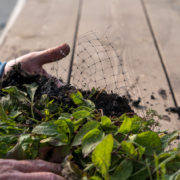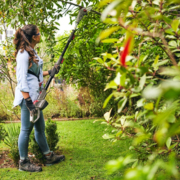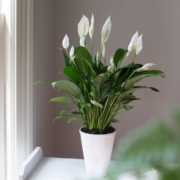How To Tame Your Out-Of-Control Garden
There are loads of things on your to-do list, and you’re frantically trying to keep all those pesky balls in the air.
From remembering to deworm the dog, pick up the dry cleaning or pay your parking fine – life’s a precarious balancing act. Yet one more pressing “chore” on the list may be to finally tackle and tame a garden that’s gone a bit wild.

How To Tame Your Out-Of-Control Garden
Perhaps during the Covid lockdowns, you had the extra time to spare to get it all spruced up. Now it’s back to the grind, and garden maintenance gets relegated to the back burner.
If your previous pride and joy now resembles the tangled depths of the Amazon rainforest, you’ll be relieved to know there are some super simple steps you can take to regain control and restore order to have your blooms, boughs and borders in Kew Garden shape in no time.
Strategies and plan ahead
Prioritising is your friend when it comes to taking back control of a garden that’s run amok. Before you get to the actual pulling and cutting, you will need a quick visual inspection and assessment of your space. You need to roughly envisage the end result.
The garden size will determine how long it will take you to clear it and whether to adopt a gradual makeover approach or hit it hard for a rapid get-it-over-and-done-with result. Keeping a gardening rota such as this handy crop rotation one from the RHS will provide you with a schedule for tracking your planting, watering, and pruning to avoid confusion and overgrowth.
Curb the clutter
Gardens choked with weeds, and overgrown bushes and trees can appear just as cluttered as houses. Every time you peek out the window and glimpse a messy garden, you’ll feel unsettled and most likely want to regain control.
The secret to taming gardens is to have the right weather, the right tools, and the correct can-do attitude.
Wave goodbye to those weeds
There’s unfortunately no way around it. Weeding and tidying are as unavoidable and healthy for a garden as a good hair trim or shave is for us humans. To begin with, simply start by pulling out the existing weeds and picking up debris.
Don’t panic – just prune…
Once you’ve won with your weeding, it’s time to tackle your trees and shrubs. If shrubs and bushes are left to grow out of control, they will become unhealthy and look unappealing.
Prune your trees (by removing oddly growing or dead branches) and shrubs back into desired shapes. Then you should meticulously assess the plants growing out of proportion and determine whether to move them or cordon them off by containing them or using clever edging techniques.
Pruning shouldn’t be undertaken willy-nilly. There are strict pruning schedules for most plants. Examples include hydrangeas, forsythia, honeysuckle, lilac, and spirea. Start pruning them early in the spring when you can trim them as low as you want. This will give them a great head start to rejuvenate and produce stunning blooms.
Witch hazel, rosemary or viburnum, for example, can only be pruned in stages, and it’s sometimes best to consult a specialist to help you with this part of the process.
Tools for taming those worrisome weeds and rogue rhododendrons
Gaining control of your garden is so much easier with suitable tools. You will require a sharp pair of secateurs for pruning, an electric lawnmower that’s easy and light to push, a hoe for purging borders of weeds, a sturdy and stiff broom for sweeping patios and paths, and an electric hedge trimmer if you have hedges.
If you have a large expanse of lawn, it may be a good idea to invest in a ride-on lawnmower (they’re great fun, too!). Gardening can be hard on the knees, so a padded kneeling mat comes in handy, as does a good set of gardening gloves to avoid scratched and sore hands. Rakes, spades, wheelbarrows, clippers, and hedgers can all contribute to the relative ease of keeping up a low-maintenance landscape.
‘Edging your bets
One of the easiest ways to keep your garden looking spick and span is to define it. Begin with a clean edge. Although it may sound easy enough, it’s relatively easy to slip into edging no-man’s-land. A sharp boundary between your lawn and your garden not only defines where the garden starts but also draws the eye there.
The contrast of green leaves and dark soil is one of the best colour combinations to add impact and delineation. You don’t always have to cut your edges into the soil – sometimes it’s easier to use an edging material such as wooden poles or rocks.
Making the most of mulch
Closely related to edging, mulching ensures moisture-retentive soil and cuts down dramatically on weed growth. For busy gardeners, this is a win-win situation, both from an aesthetic point of view and to save on labour-intensive and time-sapping watering sessions. There are plenty of different types of mulch to suit many styles, from tree bark (the darker your mulch, the more your plants will ‘pop’) to attractive pebbles or white stones.
Life-saving paving
Incorporating pavers into your garden as a walkway or patio not only makes for a very visually appealing and attractive feature, but it also cuts down on the ground cover, flower beds or lawn that require maintenance. The same goes for water features, fountains and other structures that may only require occasional cleaning and low-key upkeep.
A rock garden may provide an amazing attraction whilst minimising the slog. A large feature such as a greenhouse, gazebo or pavilion will “eat up” additional planting space but still allow you to savour all the pleasure of the outdoors. Rhino Greenhouse’s Direct has a superb range of greenhouses to suit any space and every situation.
Be picky about your plants
By being disciplined about the overabundance of aggressive species, you’ll boost your garden’s good health and create a more maintenance-friendly environment filled with beautiful plantings and features. Before adding new plants to your garden, study their care requirements and growth patterns to ensure they’re suited to your lifestyle.
A vigorously growing plant may flourish where it has plenty of room to grow and fill in a blank space. A row of shrubs may impede your garden path but make for a beautiful boundary at the rear of your landscape. So, instead of scrapping plants, simply relocate them to a more appropriate spot.
For the latest industry news visit landscapingmatters.co.uk/news
Get all of the big headlines, pictures, opinions and videos on stories that matter to you.
Follow us on Twitter and Instagram for fun, fresh and engaging content.
You can also find us on Facebook for more of your must-see news, features, videos and pictures from Landscaping Matters












